Instruction
Five Steps to Effective Practice

Matt Newby is a PGA Member and Certified Personal Coach at GolfTEC in Irvine, Calif. He has more than 10 years of experience as a teacher and other facets of the golf business. In the past he was mentored by three PGA Master Professionals and has worked with the instructors of Graeme McDowell, Martin Kaymer, Justin Rose, Padraig Harrington, Jerry Kelly and Inbee Park.
1) Know specifically what/why you are practicing.
This first step in proper practice sounds simple but is often overlooked. Countless times I’ve approached students and range-goers and asked them specifically what they are practicing. Nearly all the responses fall into two categories. The most common response is that the golfer is “just trying to hit the ball well.” Usually this person has no motive or goal related to their practice. This method may work for some golfers who are trying to blow off steam for an hour, but is ineffective for those seriously trying to improve performance. The other common response I hear is from golfers who I call “tinkerers.” They are always working on something new in their swing, whether it is a tip they saw in the latest magazine or something they heard from a playing partner. Although this category is more effective when executed properly, it often lacks execution. I challenge every reader of this article to assess their own practice and determine if they fall into either category.
Effective practice involves understanding what and why you are practicing. Golfers who are “just trying to hit the ball well” often lack specific goals for practice. Without a goal or motive for our practice the only proficiency we gain is at hitting golf balls on the range. Often this does not transfer to the golf course and is why many golfers have such dissonance in their performance on the range compared to their performance on the golf course. I am also a strong believer that you must understand why you are practicing. Students who understand why they are practicing often develop a better understanding of the process of improvement as opposed to the mentality that one tip will make them the next major champion. It also gives golfers an opportunity to gauge the source of the information received. Although most tips printed in magazines are accurate, they do not always apply to the reader and can actually cause further flaws if not implemented correctly. On the opposite end of the spectrum, advice taken from an untrained playing partner could simply be incorrect information and again can add further flaws to their game. As a PGA Professional I encourage everyone who truly wants to improve to contact their local PGA Professional. A good instructor is trained to determine what and why you should practice.
2) Know how to practice a specific skill.
How golfers practice is a mindset that needs a complete overhaul. Most golfers have a false sense of learning and the learning process. A question I ask students after every lesson is how they plan on practicing until the next lesson. I can almost guarantee that the first time I ask this the response involves the words “driving range.” The driving range is a great place to practice for certain things such as shot shaping, distance control and alignment. But attempting to practice other things such as mechanics or specific body movements on the driving range can lead to slower improvement and regression. A great coach once told me that learning to hit a full golf shot is like learning to doing a backflip on a four-foot balance beam. If I were teaching my students to do backflips on balance beams I would have to take a much different approach than how some instructors currently teach golf. In golf, students often hear the information once and then want to try it in a full swing right away. If I were to apply this same method to gymnastics I wouldn’t have any students left due to the injuries they would sustain. My business would most likely be uninsurable as well. To learn how to backflip on a balance beam, you would first start by walking on a piece of tape on the ground, then walking on a one-foot beam, then learning to do a backflip on the ground, then one-foot beam, etc. Due to the risk of injury in gymnastics, a gymnast cannot progress to the next step until a student has mastered the previous skill. The same risk applies to golf, although the risk in golf involves injuring your swing instead of falling on your head. This process applies especially for making mechanical swing changes. When making a swing change start by doing a drill to promote that change. Then you should progress to swinging in slow motion without a ball. You can speed up over time until you are at full swing speed. One of the nice things about this process is that the driving range isn’t necessary for the first steps. Swinging without the ball and in slow motion can often be done at home.
3) Set MEASURABLE goals for practice.
Measurable goals are required for any effective practice. This again goes back to the “just trying to hit the ball well” category. If you find yourself in this category, ask yourself what your definition of hitting the ball well is. Without a clear and specific goal, we have no way to determine whether we have succeeded or failed. Measurable goals apply to all types of practice, whether it’s the practice you do at home, on the range or on the course. Goals also must be specific to what you are practicing. For example, let’s say you are battling a slice. Your specific definition of hitting it well would probably be “not slicing.” This can then be turned into a measurable goal. First you would start by creating a virtual fairway on the driving range by using two flags or markers (blue flag on left and red on right). This would serve as your measuring device. Now you have to create a goal. In this example your goal could be to hit less than three out of 10 balls to the right of the red flag. Just by using this simple goal you now have a way to analyze your practice and determine whether or not it was effective. This same system could apply to all your practice even if you were working on mechanics at home. One key that must be stated is that a measuring device must always be created to determine success or failure. In the last example our measurement device was our virtual fairway. Creating an effective measuring device is not always as easy to re-create at home. A video camera is usually a good solution to determine if practice was effective. The video does not lie as much as we would sometimes like it to.
4) Create a game plan.
Now that you have your goals established you need to create a game plan for your practice session. A game plan needs to be specific to the goals for that practice session. Based on my personal experience I feel that the game plan of most amateurs when practicing consists of hitting a bucket with whatever club they feel necessary at the time. Much of the time I also watch amateurs hit the same club at the same flag repeatedly. Hitting balls at the same flag over and over unfortunately does not follow the same rhythm as a round of golf. On the golf course, it is rare that we hit the same shot more than once, so it makes no sense to practice this way. This only leads to the dissonance that most golfers experience between the driving range and the golf course. By creating situations in your practice similar to those you would find on the golf course, the gap in performance between the range and the course will start to dissipate. If your goal is to hit eight out of 10 greens with a wedge, you might hit a driver and possibly a mid-iron before each wedge shot to recreate the rhythm of an actual round of golf. You can also play games with yourself this way to make your practice more enjoyable. For example, if your drive lands outside your virtual fairway, then make yourself hit a mid-iron before you hit your next wedge wedge. If you bomb your drive down the middle, you might go straight to the wedge and try to recreate an on-course birdie opportunity.
5) Analyze results and compare to goals.
This is one of the most important and easiest steps, but also the scariest step for most golfers. Analyzing results implies the possibility of failure, but also success. I think most golfers want to believe that any practice is good practice. Unfortunately that is just not true. Golfers need to understand that there can be failure during practice. Because your goals are measurable it makes the actual analysis very easy. Keep a record of how you performed based on your goals. If you were to use the three out of 10 shots in the “don’t slice” game, you would keep a tally on a notepad or scorecard of each set of 10 shots that you hit. Keeping this record will also allow you to analyze your progress over time and revise your goals based on progress. Once you understand why you fail you will be able to practice more effectively in the future.
Matt Newby is a PGA Member and Certified Personal Coach at GolfTEC in Irvine, Calif. He has more than 10 years of experience as a teacher and other facets of the golf business. In the past he was mentored by three PGA Master Professionals and has worked with the instructors of Graeme McDowell, Martin Kaymer, Justin Rose, Padraig Harrington, Jerry Kelly and Inbee Park.
- LIKE17
- LEGIT8
- WOW7
- LOL3
- IDHT0
- FLOP0
- OB0
- SHANK0
Instruction
The Wedge Guy: The easiest-to-learn golf basic

My golf learning began with this simple fact – if you don’t have a fundamentally sound hold on the golf club, it is practically impossible for your body to execute a fundamentally sound golf swing. I’m still a big believer that the golf swing is much easier to execute if you begin with the proper hold on the club.
As you might imagine, I come into contact with hundreds of golfers of all skill levels. And it is very rare to see a good player with a bad hold on the golf club. There are some exceptions, for sure, but they are very few and very far between, and they typically have beat so many balls with their poor grip that they’ve found a way to work around it.
The reality of biophysics is that the body moves only in certain ways – and the particulars of the way you hold the golf club can totally prevent a sound swing motion that allows the club to release properly through the impact zone. The wonderful thing is that anyone can learn how to put a fundamentally sound hold on the golf club, and you can practice it anywhere your hands are not otherwise engaged, like watching TV or just sitting and relaxing.
Whether you prefer an overlap, interlock or full-finger (not baseball!) grip on the club, the same fundamentals apply. Here are the major grip faults I see most often, in the order of the frequency:
Mis-aligned hands
By this I mean that the palms of the two hands are not parallel to each other. Too many golfers have a weak left hand and strong right, or vice versa. The easiest way to learn how to hold the club with your palms aligned properly is to grip a plain wooden ruler or yardstick. It forces the hands to align properly and shows you how that feels. If you grip and re-grip a yardstick several times, then grip a club, you’ll see that the learning curve is almost immediate.
The position of the grip in the upper/left hand
I also observe many golfers who have the butt of the grip too far into the heel pad of the upper hand (the left hand for right-handed players). It’s amazing how much easier it is to release the club through the ball if even 1/4-1/2″ of the butt is beyond the left heel pad. Try this yourself to see what I mean. Swing the club freely with just your left hand and notice the difference in its release from when you hold it at the end of the grip, versus gripping down even a half inch.
To help you really understand how this works, go to the range and hit shots with your five-iron gripped down a full inch to make the club the same length as your seven-iron. You will probably see an amazing shot shape difference, and likely not see as much distance loss as you would expect.
Too much lower (right) hand on the club
It seems like almost all golfers of 8-10 handicap or higher have the club too far into the palm of the lower hand, because that feels “good” if you are trying to control the path of the clubhead to the ball. But the golf swing is not an effort to hit at the ball – it is a swing of the club. The proper hold on the club has the grip underneath the pad at the base of the fingers. This will likely feel “weak” to you — like you cannot control the club like that. EXACTLY. You should not be trying to control the club with your lower/master hand.
Gripping too tightly
Nearly all golfers hold the club too tightly, which tenses up the forearms and prevents a proper release of the club through impact. In order for the club to move back and through properly, you must feel that the club is controlled by the last three fingers of the upper hand, and the middle two fingers of the lower hand. If you engage your thumbs and forefingers in “holding” the club, the result will almost always be a grip that is too tight. Try this for yourself. Hold the club in your upper hand only, and squeeze firmly with just the last three fingers, with the forefinger and thumb off the club entirely. You have good control, but your forearms are not tense. Then begin to squeeze down with your thumb and forefinger and observe the tensing of the entire forearm. This is the way we are made, so the key to preventing tenseness in the arms is to hold the club very lightly with the “pinchers” — the thumbs and forefingers.
So, those are what I believe are the four fundamentals of a good grip. Anyone can learn them in their home or office very quickly. There is no easier way to improve your ball striking consistency and add distance than giving more attention to the way you hold the golf club.
More from the Wedge Guy
- The Wedge Guy: Golf mastery begins with your wedge game
- The Wedge Guy: Why golf is 20 times harder than brain surgery
- The Wedge Guy: Musings on the golf ball rollback
- LIKE85
- LEGIT13
- WOW6
- LOL1
- IDHT0
- FLOP4
- OB1
- SHANK8
Instruction
Clement: Stop ripping off your swing with this drill!

Not the dreaded headcover under the armpit drill! As if your body is defective and can’t function by itself! Have you seen how incredible the human machine is with all the incredible feats of agility all kinds of athletes are accomplishing? You think your body is so defective (the good Lord is laughing his head off at you) that it needs a headcover tucked under the armpit so you can swing like T-Rex?
- LIKE0
- LEGIT2
- WOW2
- LOL0
- IDHT0
- FLOP0
- OB0
- SHANK2
Instruction
How a towel can fix your golf swing
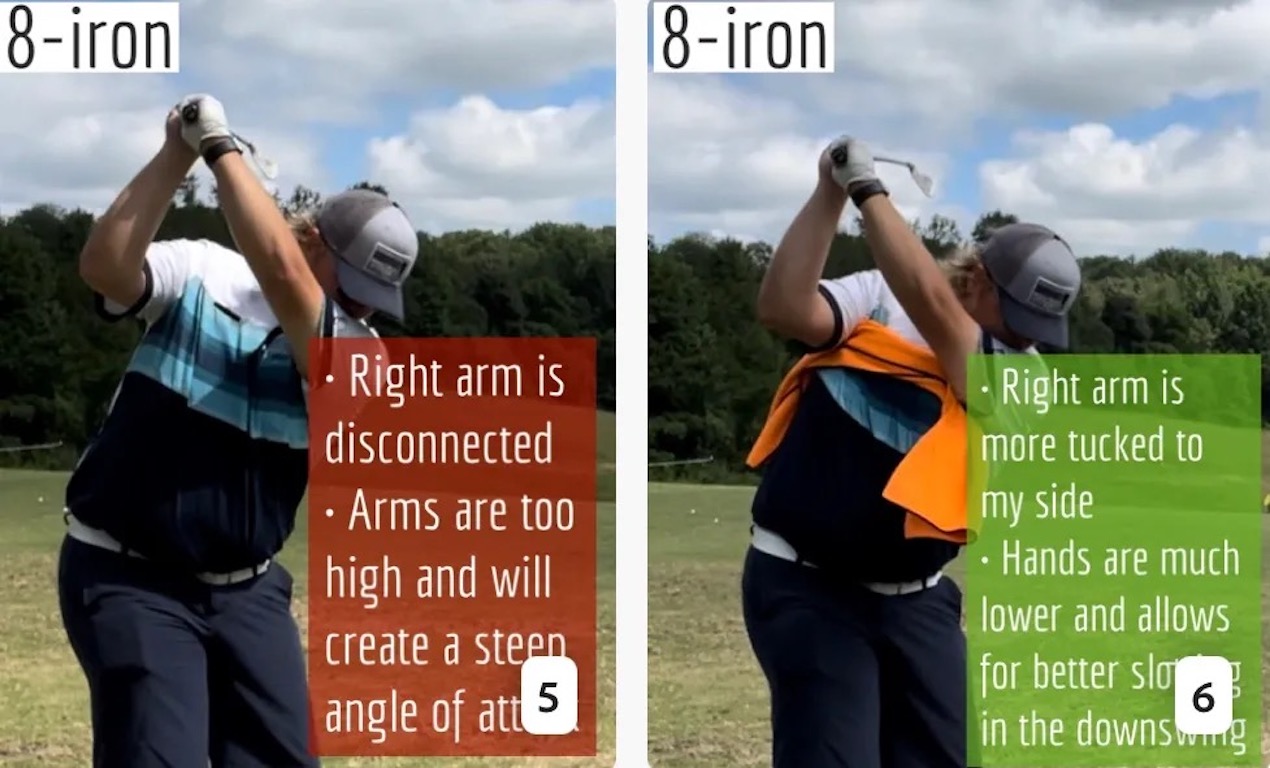
This is a classic drill that has been used for decades. However, the world of marketed training aids has grown so much during that time that this simple practice has been virtually forgotten. Because why teach people how to play golf using everyday items when you can create and sell a product that reinforces the same thing? Nevertheless, I am here to give you helpful advice without running to the nearest Edwin Watts or adding something to your Amazon cart.
For the “scoring clubs,” having a solid connection between the arms and body during the swing, especially through impact, is paramount to creating long-lasting consistency. And keeping that connection throughout the swing helps rotate the shoulders more to generate more power to help you hit it farther. So, how does this drill work, and what will your game benefit from it? Well, let’s get into it.
Setup
You can use this for basic chip shots up to complete swings. I use this with every club in my bag, up to a 9 or 8-iron. It’s natural to create incrementally more separation between the arms and body as you progress up the set. So doing this with a high iron or a wood is not recommended.
While you set up to hit a ball, simply tuck the towel underneath both armpits. The length of the towel will determine how tight it will be across your chest but don’t make it so loose that it gets in the way of your vision. After both sides are tucked, make some focused swings, keeping both arms firmly connected to the body during the backswing and follow through. (Note: It’s normal to lose connection on your lead arm during your finishing pose.) When you’re ready, put a ball in the way of those swings and get to work.
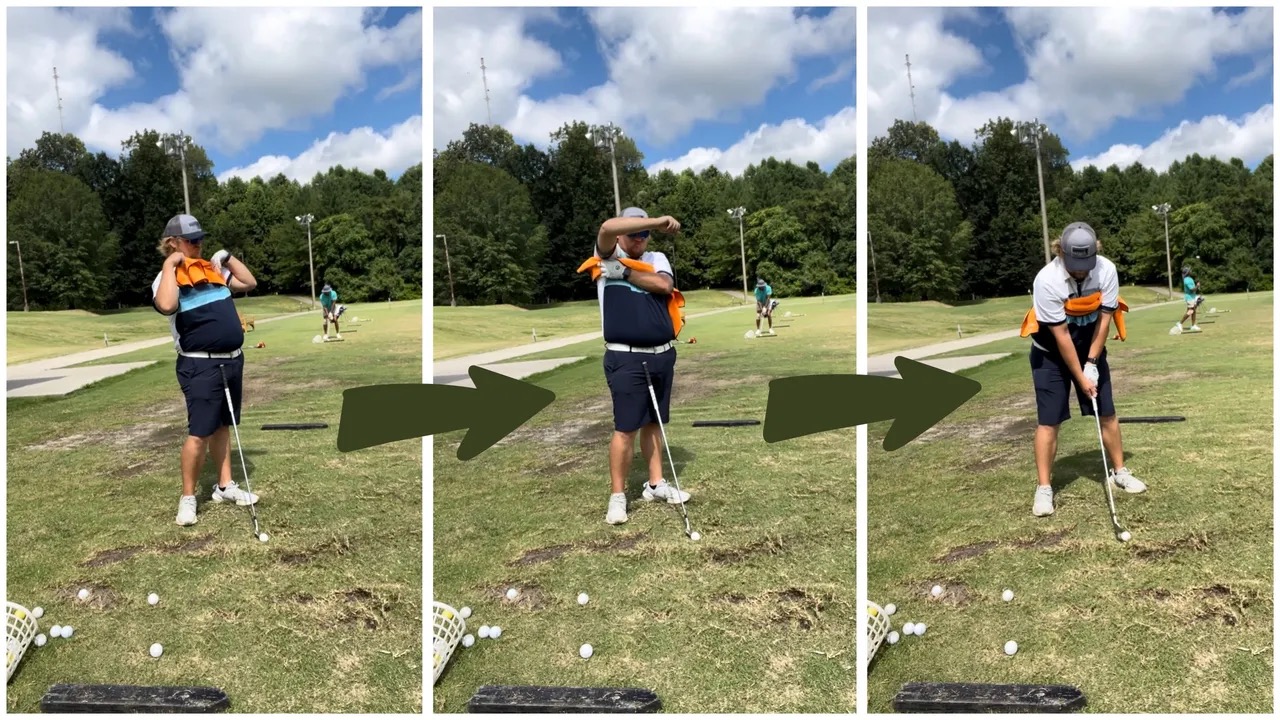
Get a Better Shoulder Turn
Many of us struggle to have proper shoulder rotation in our golf swing, especially during long layoffs. Making a swing that is all arms and no shoulders is a surefire way to have less control with wedges and less distance with full swings. Notice how I can get in a similar-looking position in both 60° wedge photos. However, one is weak and uncontrollable, while the other is strong and connected. One allows me to use my larger muscles to create my swing, and one doesn’t. The follow-through is another critical point where having a good connection, as well as solid shoulder rotation, is a must. This drill is great for those who tend to have a “chicken wing” form in their lead arm, which happens when it becomes separated from the body through impact.
In full swings, getting your shoulders to rotate in your golf swing is a great way to reinforce proper weight distribution. If your swing is all arms, it’s much harder to get your weight to naturally shift to the inside part of your trail foot in the backswing. Sure, you could make the mistake of “sliding” to get weight on your back foot, but that doesn’t fix the issue. You must turn into your trial leg to generate power. Additionally, look at the difference in separation between my hands and my head in the 8-iron examples. The green picture has more separation and has my hands lower. This will help me lessen my angle of attack and make it easier to hit the inside part of the golf ball, rather than the over-the-top move that the other picture produces.
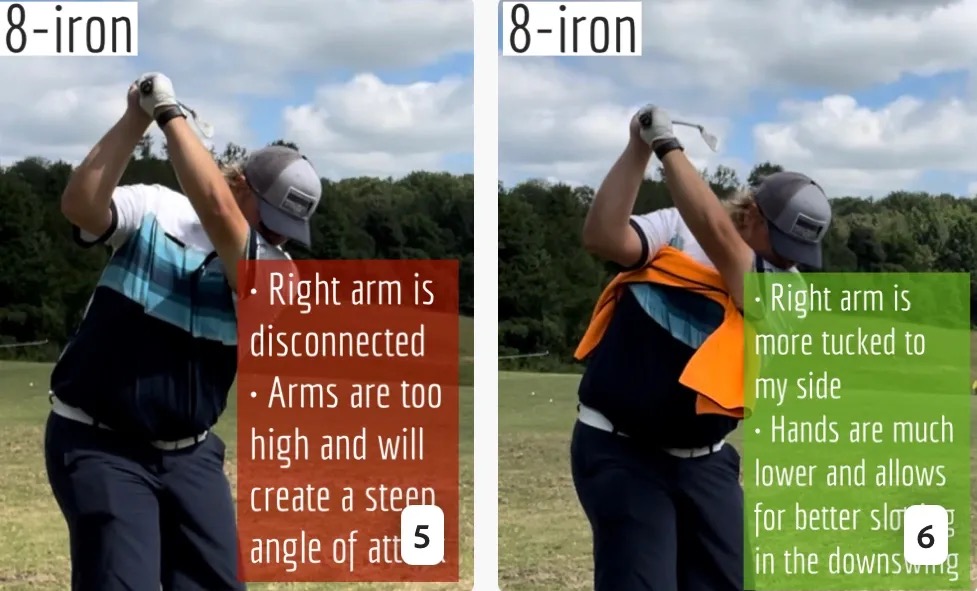
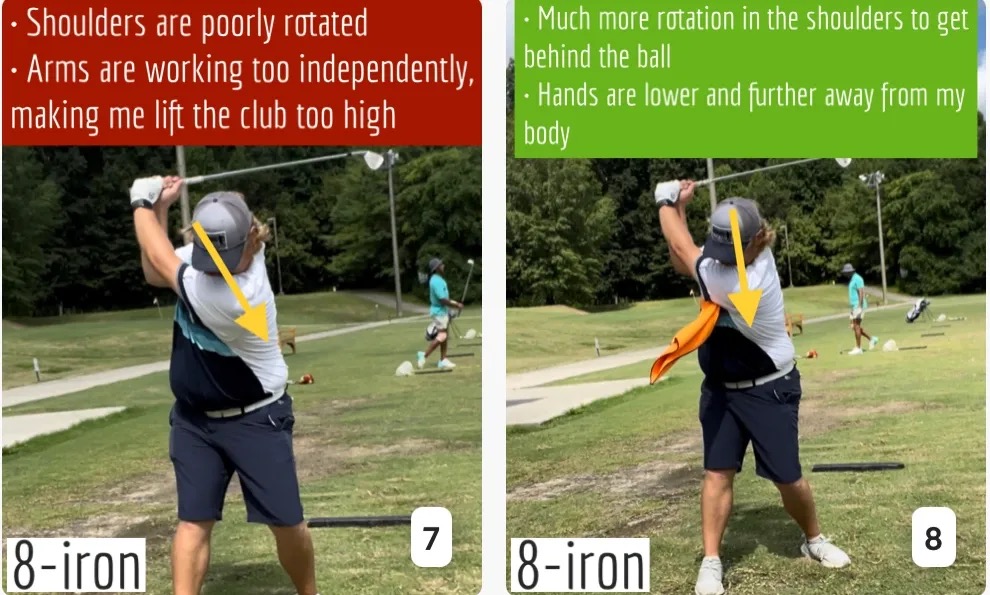
Stay Better Connected in the Backswing
When you don’t keep everything in your upper body working as one, getting to a good spot at the top of your swing is very hard to do. It would take impeccable timing along with great hand-eye coordination to hit quality shots with any sort of regularity if the arms are working separately from the body.
Notice in the red pictures of both my 60-degree wedge and 8-iron how high my hands are and the fact you can clearly see my shoulder through the gap in my arms. That has happened because the right arm, just above my elbow, has become totally disconnected from my body. That separation causes me to lift my hands as well as lose some of the extension in my left arm. This has been corrected in the green pictures by using this drill to reinforce that connection. It will also make you focus on keeping the lead arm close to your body as well. Because the moment either one loses that relationship, the towel falls.
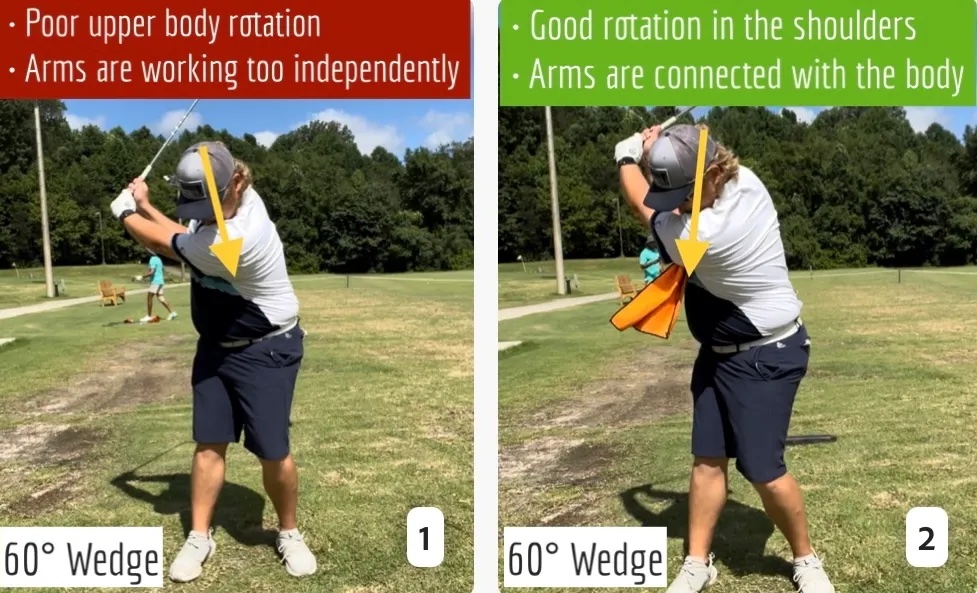
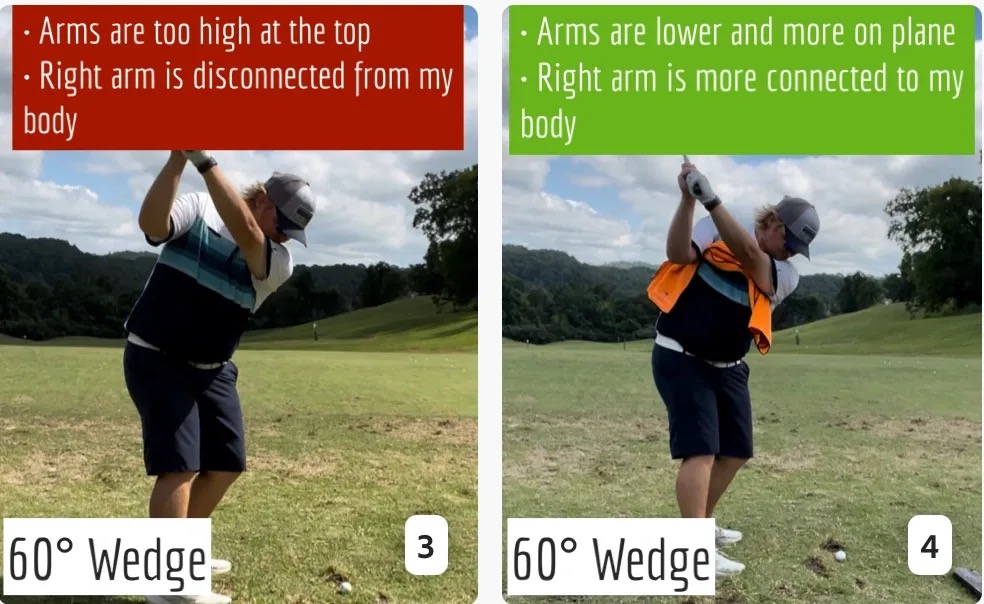
Conclusion
I have been diligent this year in finding a few drills that target some of the issues that plague my golf game; either by simply forgetting fundamental things or by coming to terms with the faults that have bitten me my whole career. I have found that having a few drills to fall back on to reinforce certain feelings helps me find my game a little easier, and the “towel drill” is most definitely one of them.
- LIKE12
- LEGIT2
- WOW2
- LOL0
- IDHT0
- FLOP2
- OB0
- SHANK8
-

 19th Hole6 days ago
19th Hole6 days agoDave Portnoy places monstrous outright bet for the 2024 Masters
-
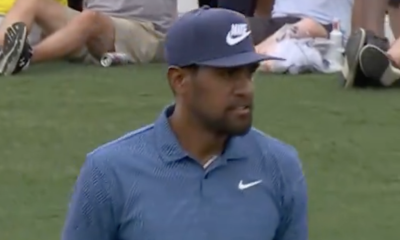
 19th Hole2 weeks ago
19th Hole2 weeks agoThings got heated at the Houston Open between Tony Finau and Alejandro Tosti. Here’s why
-

 19th Hole1 week ago
19th Hole1 week agoTiger Woods arrives at 2024 Masters equipped with a putter that may surprise you
-

 19th Hole2 weeks ago
19th Hole2 weeks agoReport: Tiger Woods has ‘eliminated sex’ in preparation for the 2024 Masters
-

 19th Hole2 days ago
19th Hole2 days agoTwo star names reportedly blanked Jon Rahm all week at the Masters
-

 19th Hole2 days ago
19th Hole2 days agoNeal Shipley presser ends in awkward fashion after reporter claims Tiger handed him note on 8th fairway
-

 19th Hole2 weeks ago
19th Hole2 weeks agoAddiction, spinal fusion, and scam artists – Everything Anthony Kim revealed in candid interview with David Feherty
-

 19th Hole2 weeks ago
19th Hole2 weeks agoAnthony Kim says doctors told him that he ‘may not have much time left’ ahead of LIV return

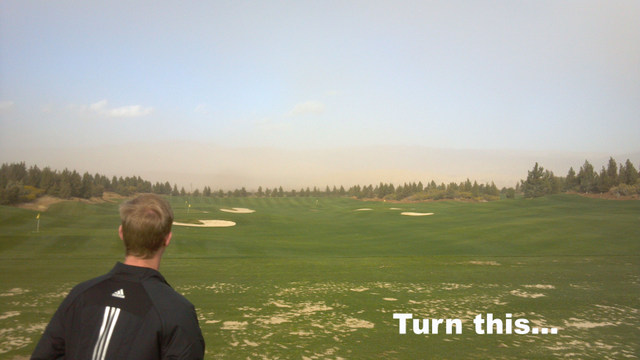









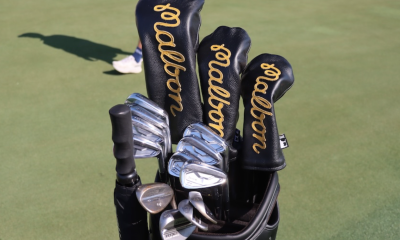

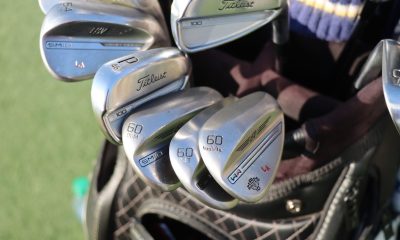

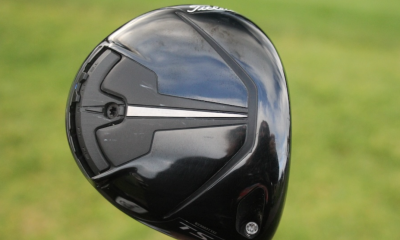

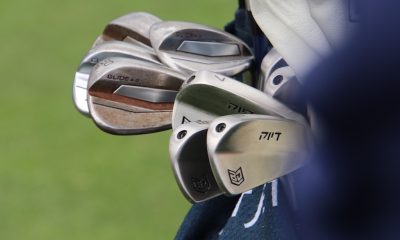

rick rappaport
Feb 29, 2012 at 1:54 pm
Bravo! What a well written and well thought out article. My practice will change from now on and it sounds like it’s going to be a lot more fun, too.
Jason
Feb 29, 2012 at 11:06 am
I’ve have often times recreated golf round scenarios at the end of a bucket when I only have a few balls left. Never have thought about trying to do that with the whole practice although it makes since of why it is a good technique. Going to try to start getting more quality range time in this week and in the months to come so I am looking forward to trying this out next time. Thanks for the article.
Jason Black
Jan 30, 2012 at 3:13 pm
Great article. I had my high school golf team read this and write a paper about it.
Pete
Jan 28, 2012 at 3:13 pm
Excellent tips! Applying a focused quantitative goal is the way to practice smarter, not harder. Thank you much!
Marvin Brush
Jan 27, 2012 at 9:49 pm
Good article Matt. Looking forward in see you once I get some pain out of my left hand finger.
Marv
Mark Carlson
Jan 27, 2012 at 4:05 pm
Currently on the DL while rehabbing after elbow surgery, but I will keep this in mind when I pick up the clubs again in a couple of months. Good stuff. Thanks for the post!
Matt Newby
Jan 25, 2012 at 8:22 pm
If anybody has any questions or comments please feel free to contact me at [email protected]